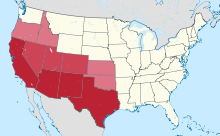Aztlan
According to legend, Aztlán is the original homeland of the Aztecs . The Aztecs usually referred to themselves as Mexica , but in relation to their origins they called themselves Azteca (singular: Aztecatl ), "those from Aztlán". Aztlán was described as an island in a lake. From there, the Aztecs, led by their god Huitzilopochtli , are said to have migrated to the Valley of Mexico , where they founded the city of Tenochtitlán on an island in Lake Texcoco .
etymology
The meaning of Aztlán (this is the Spanish spelling), unlike most of the Nahuatl (Aztec language) place names, is not clear. The frequently found translation as the place of the whites , land of the herons of Nahuatl azta (tl) = white bird (heron or crane) + -tlan = place suffix (on or near) is incorrect and would only apply to one place Aztatlan . For the name Aztlan (the emphasis is on the first syllable in Nahuatl) no character has been identified in the Aztec script . The place symbol that can be found in the Codex Boturini and some other Aztec codices for Aztlan, however, cannot be explained.
Localization
The exact location of Aztlán is not known. Legend only says it was said to have been north of Mexico City , but there is no clue as to its distance. This vague specification enabled a multitude of different localizations. According to the pre-Hispanic traditions, the Azteca migrated over an incomprehensible route to Tula and from there in the smallest stages over places that still exist today in the basin of Mexico.
José Fernando Ramírez suspected Aztlán in the high valley of Mexico, Paul Kirchhoff on the Río Lerma near Yuriria, García Cubas and Alfredo Chavero on the island of Mexcaltitán in the lagoon area of the west coast of Mexico. Manuel Orozco y Berra localized the place in the Lake of Chapala , Lorenzo Boturini de Benaducci and Hubert Howe Bancroft in Baja California , Mariano Fernández de Echeverría y Veytia and the author of the Códice Ramírez north of Sonora , Francisco Clavijero and Pérez Verdía in California , the Indian colonial era Author Fernando Alvarado Tezozómoc in New Mexico , Alexander von Humboldt and William Hickling Prescott in the Northwest of the USA , Wickersham on Puget Sound , NF Hyer in Aztalan, Wisconsin . Authors like Ignatius Donnelly even said that Aztlán is the mythical continent of Atlantis .
According to the assumption of the anthropologist Alfredo Chavero from 1887 that Aztlán is located on the Pacific coast in the Mexican state of Nayarit , the state has the symbol of Aztlán in the coat of arms with the state motto "Nayarit, cradle of the Mexicans".
Today, many historians consider Aztlán to be a mythical place, the description of which is inspired by the actual residential area of the Aztecs in the Valley of Mexico , and which therefore defies localization.
Political importance
The name Aztlán was picked up by several Mexican political movements in the United States . In this context, the entire southwestern United States is referred to as Aztlán . On the grounds that this country was the original home of the Aztecs, that it belonged to Mexico until the Treaty of Guadalupe Hidalgo in 1848 and that there is now a high proportion of Mexicans there, nationalist , irredentist groups are demanding independence or reunification with Mexico.
The name "Aztlán" was first used by a group of Chicano activists led by Oscar Zeta Acosta in the 1960s. They used it to refer to the areas of northern Mexico that were annexed by the United States in the wake of the Mexican-American War . Some historical linguists and anthropologists also claim that the original settlement area of the Aztec peoples was located in the southwest of the United States, even if these areas today are more closely related to the historical Indian tribes Navajo, Hopi, Apache, Comanche, Shoshone, Mojave, Zuni and others Be associated.
Aztlán became a "symbol" for mestizo activists who claimed a just and original right to the land, even if they came into conflict with some Indian tribes. Other scientists locate Aztlan in what is now Mexico.
Groups that use the name in this context are Plan Espiritual de Aztlán and MEChA (Movimiento Estudiantil Chicano de Aztlán, "Chicano Student Movement of Aztlán"). In the Chicano movement, the poet Alurista is voted for distribution through a poem at the Chicano Youth Liberation Conference in Denver, Colorado in March 1969.
effect
Some novelists have taken up this idea and refer to a future state in the southwest of the USA and / or Mexico as Aztlán , such as Whitley Strieber in the novel Warday or the role-playing game and the series of novels Shadowrun .
Individual evidence
- ↑ Alurista Essay - Critical Essays . In: eNotes . Retrieved September 23, 2015.
literature
- Juan Gómez-Quiñones, Irene Vásquez: Making Aztlán: Ideology and Culture of the Chicana and Chicano Movement, 1966-1977. 2014.
Web links
- NetworkAztlan.com - Network Aztlan

